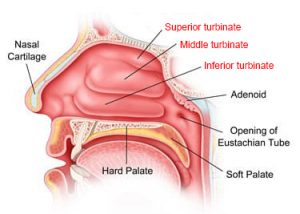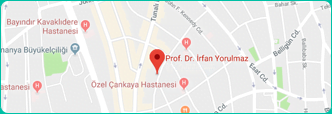Nasal turbinates

There are three structures called turbinates, on each side wall of inside of the nose. They are named as superior, middle and inferior turbinates. They increase in size from top to bottom; the superior turbinate is the smallest and the inferior turbinate is the largest.
The turbinates help to heat, humidify and filter the inhaled air. They have plenty of blood vessels in them and their size change with ait temperature, humidity, body activity, position, and hormonal changes.
Turbinate hypertrophy
Often the largest inferior turbinates block nasal airflow when they are further enlarged. This is called turbinate hypertrophy and causes nasal obstruction mainly during exercise and sleep. Nasal obstruction is more evident in the presence of a deviated septum.
The most common cause of turbinate hypertrophy is allergy. Other causes are chronic sinusitis, tobacco use or passive smoking, chemical gas inhalation, air pollution and prolonged use of nasal sprays or drops.
Medical treatment
For many patients, medications can help reduce the size of the turbinates and can help improve their nasal obstruction.
- Decongestants may relieve nasal obstruction for a limited time of their action. Their continuous use is not possible and yhey cannot be used in patients with high blood pressure, heart and kidney problems, prostate enlargement in men, and glaucoma.
- Nasal rinsing with hypertonic saline may be is useful for short-term relief of nasal obstruction.
- Antihistamines are useful in patients with allergies.
- Steroid nasal sprays are appropriate for long-term use, particularly in patients with allergies.
- Decongestant nasal sprays have a very effective short-term benefit for nasal obstruction. However, continuous use of such sprays may lead to further enlargement of turbinates and increased nasal congestion, and should be avoided.
Surgical treatment
Surgical treatment of turbinate hypertrophy aims to shrink the turbinates without removing the turbinate bone or tissue. Reduction of turbinates can be achieved in different ways:

- Radiofrequency reduction is the most preferred method. Certain points of the turbinate is heated up with a special device. Over time, scar tissue forms in the heated portion of turbinate, causing the turbinate to shrink in size.
- Partial resection
- Microdebrider resection
- Cauterization
- Laser reduction
The choice of method to reduce the hypertrophied turbinate depends on the preference and experience of your doctor and the appearance of the turbinate.
After turbinate surgery, it may be necessary to place a dressing in the nose for one or two days, to prevent bleeding. During the first week following turbinate surgery, the nasal obstruction is increased due to dressings, swelling (edema), crusting, thickening and increase of secretions. It may take 6 to 8 weeks for the turbinates to shrink and get the final result of surgery.
It is important that the turbinate not be removed completely. Complete turbinate removal can result in a very dry and crusty nose. Occasionally, turbinate tissue will re-grow after turbinate surgery and the procedure may need to be repeated. This is preferable to the situation of irreversible total removal of the turbinate.


